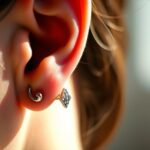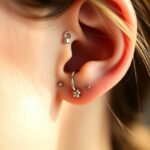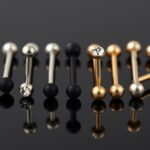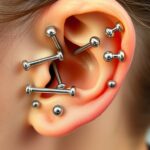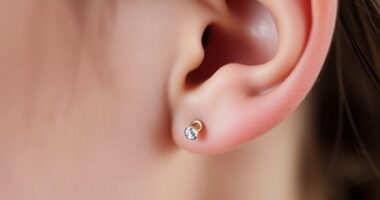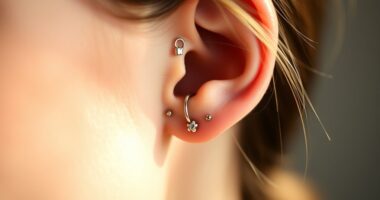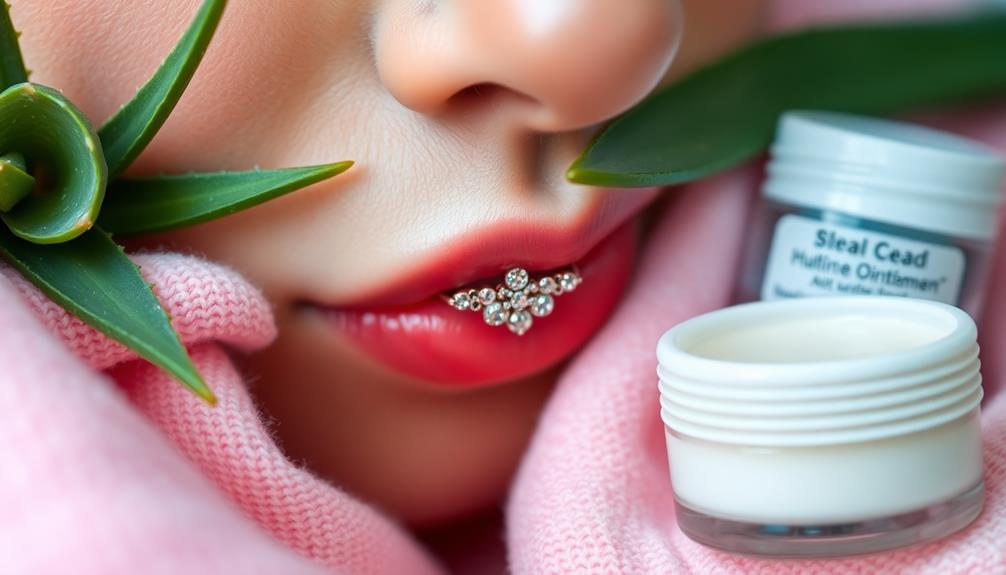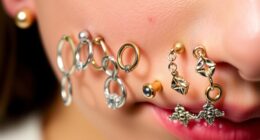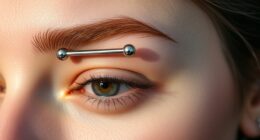Choosing between a rook and a snug piercing depends on your style and patience. Rook piercings are more visible, ideal if you want a bold statement, but they take longer to heal—around 6 to 8 months—and require more jewelry options. Snugs are subtler, heal faster—about 4 to 6 months—and suit minimalist tastes. To find out which fits your vibe and needs best, keep exploring the details below.
Key Takeaways
- Rook piercings are more visible and allow for diverse jewelry styles but have longer healing times of 6-8 months.
- Snug piercings are discreet with quicker healing, typically 4-6 months, ideal for minimalist looks.
- Rook’s curved shape offers more adventurous jewelry options like hoops and captive rings.
- Snugs are suited for smaller, secure jewelry such as tiny hoops or straight barbells.
- Consider your aesthetic preference, lifestyle, and willingness to maintain longer healing and aftercare routines.
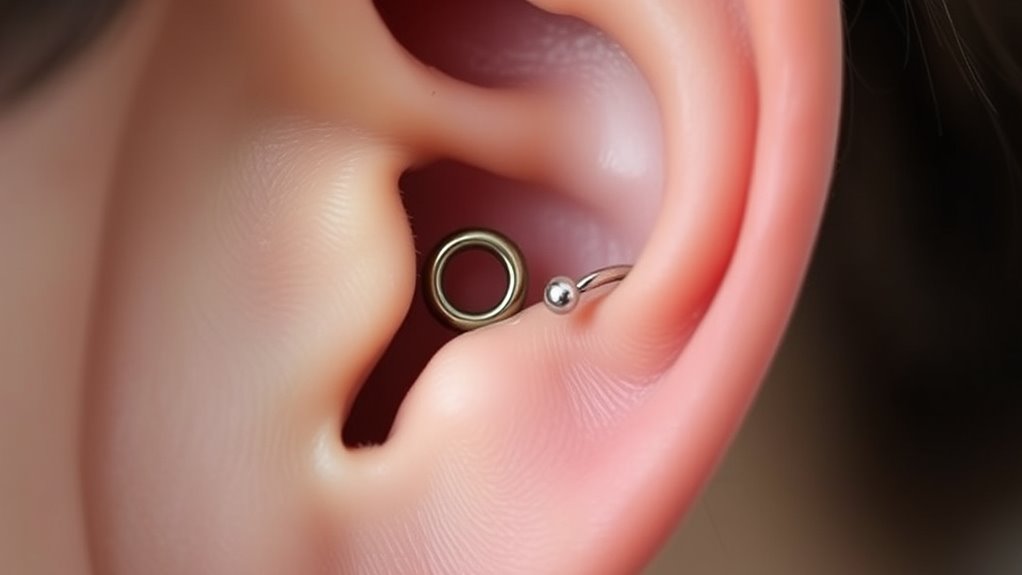
If you’re considering cartilage piercings, understanding the differences between a rook and a snug can help you choose the right one. Both piercings are located in the upper ear, but they target different cartilage areas, which influences jewelry choices and healing times. The rook piercing goes through the fold of cartilage that sits above the ear canal, creating a striking, curved look. In contrast, the snug piercing is placed in the inner cartilage ridge, closer to the ear’s center, resulting in a more discreet, snug fit. Knowing these distinctions helps you decide which matches your style and lifestyle.
When it comes to jewelry choices, both piercings offer versatile options, but their placement influences what works best. Rook piercings typically accommodate a variety of jewelry styles, including hoops, captive bead rings, and curved barbells. The curved shape of the rook allows for more adventurous jewelry, giving you a chance to express your personality. Snug piercings, being more embedded and snug against the ear, often favor smaller, more secure jewelry like tiny hoops or straight barbells. If you prefer a more subtle or minimalist look, the snug might be the better option, but if you want a statement piece, the rook provides broader possibilities.
Healing times are another essential factor. Rook piercings generally take about 6 to 8 months to fully heal, although some people might experience longer healing periods depending on how well they care for the piercing. The cartilage in this area is thicker and takes longer to heal than lobe piercings, so patience and diligent aftercare are essential. Snug piercings tend to heal slightly faster, usually around 4 to 6 months, but still require careful maintenance to prevent complications. Both piercings are prone to swelling, infection, and cartilage damage if not properly cared for, so expect some downtime regardless of which you choose. Additionally, proper aftercare is vital to prevent complications and ensure a smooth healing process.
Ultimately, your choice depends on your aesthetic preferences and your willingness to commit to aftercare. The rook offers more jewelry flexibility and a bold look, but with longer healing times. The snug provides a more discreet option with quicker healing but fewer jewelry styles. Whichever you pick, prioritize hygiene, follow your piercer’s instructions, and be patient as your cartilage heals. With proper care, both piercings can become striking features that showcase your unique style and personality.
Frequently Asked Questions
How Long Does It Take for Rook and Snug Piercings to Heal?
Your rook and snug piercings typically take 6 to 12 weeks to heal, but healing timelines vary depending on aftercare. During this period, follow aftercare tips like cleaning with saline, avoiding touching or twisting the jewelry, and keeping your ears dry. Proper care speeds healing and reduces infection risk. Be patient and consistent with your aftercare routine, and consult your piercer if you notice signs of trouble.
Are Rook or Snug Piercings More Prone to Infection?
They say “prevention is better than cure,” and this applies to piercings too. Rook and snug piercings have similar infection risks, but snug piercings might be slightly more prone to infection due to their location and cartilage thickness, which can lead to piercing complications if not cared for properly. Keep your piercing clean, avoid touching it, and follow your piercer’s aftercare instructions to minimize infection risk.
Can I Wear Headphones Comfortably With Either Piercing?
Yes, you can wear headphones comfortably with either rook or snug piercings, but ear cartilage considerations matter. Both piercings sit close to the ear canal, so choose jewelry options like small hoops or flat studs to prevent discomfort. Make certain your jewelry isn’t too bulky or heavy, which can cause irritation or pressure. Taking care of your piercing and selecting comfortable, lightweight jewelry will help you enjoy headphones without issues.
Which Piercing Is More Suitable for Active Lifestyles?
While both piercings are stylish, the rook piercing tends to be more suitable for active lifestyles because of its ear cartilage durability, making it less prone to damage during physical activities. The snug piercing, being closer to the ear canal, may be more vulnerable and less comfortable during intense movement. Consider piercing visibility and how it aligns with your activity level to choose the best option for your active routines.
How Do I Choose Between Rook and Snug Based on Ear Shape?
To choose between a rook and a snug piercing based on ear shape considerations, assess your ear anatomy. If your ear has a thicker, more prominent fold, a rook piercing may suit you, offering more visibility options and a striking look. For narrower or less prominent ear shapes, a snug piercing provides a subtle, hidden option that complements your ear’s natural contours. Consider how each piercing aligns with your style and comfort preferences.
Conclusion
Ultimately, choosing between a rook and a snug piercing comes down to your style and comfort. Some say the rook’s subtlety makes it a safer, easier option, while others believe the snug’s unique placement offers a bold statement. notably, recent studies suggest that piercings in more cartilage-heavy areas might heal faster than expected, challenging old myths. So, trust your instincts, do your research, and pick the one that truly resonates with your personality — your perfect piercing awaits.
Piecing together a life one day at a time, that’s me. I’m Rusty, and I love being editor-in-chief of creative piercing. It’s my passion to help others see their vision and bring it to life. When I’m not working or taking care of my family, you can find me reading a good book or eating pie (of course!).


